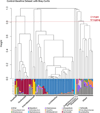The new world of the urinary microbiota in women
- PMID: 26003055
- PMCID: PMC4876712
- DOI: 10.1016/j.ajog.2015.05.032
The new world of the urinary microbiota in women
Abstract
Emerging evidence challenges the long-held paradigm that the healthy bladder is sterile. These discoveries may provide new opportunities to address important women's health conditions, which include preterm labor and delivery, urinary tract infections, and common forms of urinary incontinence. Traditional tools for urinary bacterial assessment, which includes urinary dipsticks and standard urine cultures, have significant limitations that restrict the information that is available to clinicians. For example, the standard urine culture does not detect slow-growing bacteria that die in the presence of oxygen. Two new, complementary tools, however, can detect these and other organisms, which permits a more complete characterization of bacterial communities within the female bladder. Obstetrician-gynecologists should become familiar with these new approaches (expanded quantitative urine culture and 16S ribosomal RNA gene sequencing) that can detect previously unrecognized organisms. These advances are making it possible to answer previously intractable scientific and clinical questions. Traditional nomenclature used to describe the bacterial status in the bladder is quite dated and unsuited for the emerging information about the bacterial milieu of the female urinary tract. In the context of the sterile bladder paradigm, clinicians have learned about "uropathogens," "asymptomatic bacteriuria," and "urinary tract infection." Given that the lower urinary tract is not sterile, these terms should be reevaluated. Clinicians can already benefit from the emerging knowledge regarding urinary organisms that have previously gone undetected or unappreciated. For example, in some subpopulations of women with urinary symptoms, existing data suggest that the urinary bacterial community may be associated with women's health conditions of interest. This Clinical Opinion highlights the inadequacies of the current tools for urinary bacterial assessment, describes the new assessment tools, explains the current interpretation of the resulting data, and proposes potential clinical uses and relevance. A new world is opening to our view that will give us the opportunity to better understand urinary bacteria and the bladder in which they live. This new knowledge has significant potential to improve patient care in obstetrics and gynecology.
Keywords: 16S rRNA sequencing; asymptomatic bacteriuria; microbiome; microbiota; urgency urinary incontinence; urinary tract infection; urine culture.
Copyright © 2015 The Authors. Published by Elsevier Inc. All rights reserved.
Figures


Comment in
-
Evidence against an etiological role of lactobacilli and diphtheroids in dysuria and frequency in females.Am J Obstet Gynecol. 2016 Sep;215(3):403. doi: 10.1016/j.ajog.2016.05.014. Epub 2016 May 12. Am J Obstet Gynecol. 2016. PMID: 27180884 No abstract available.
-
Reply.Am J Obstet Gynecol. 2016 Sep;215(3):403. doi: 10.1016/j.ajog.2016.05.015. Epub 2016 May 13. Am J Obstet Gynecol. 2016. PMID: 27185743 No abstract available.
References
-
- Woo PC, Lau SK, Teng JL, Tse H, Yuen KY. Then and now: use of 16S rDNA gene sequencing for bacterial identification and discovery of novel bacteria in clinical microbiology laboratories. Clin Microbiol Infect. 2008;14:908–934. - PubMed
-
- Chun J, Rainey FA. Integrating genomics into the taxonomy and systematics of the Bacteria and Archaea. Int J Syst Evol Microbiol. 2014;64:316–324. - PubMed
Publication types
MeSH terms
Substances
Grants and funding
LinkOut - more resources
Full Text Sources
Other Literature Sources
Medical

